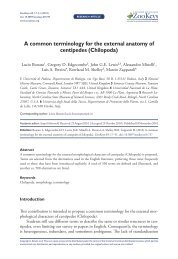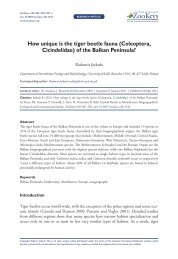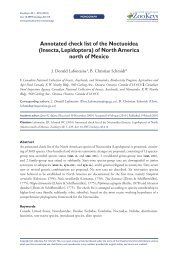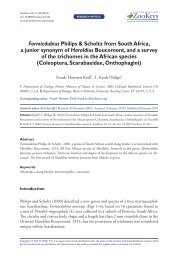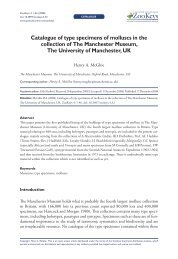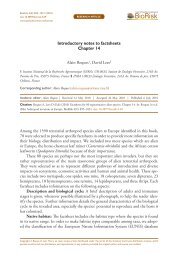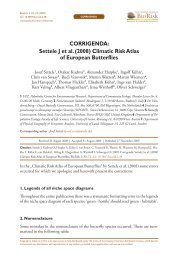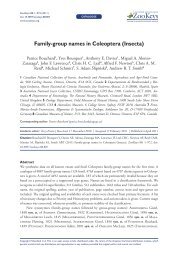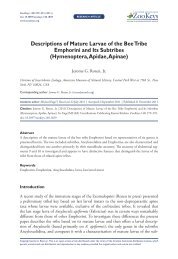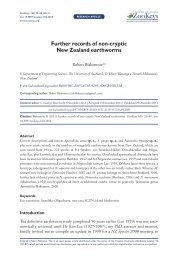Coleoptera, Cerambycidae - Pensoft Publishers
Coleoptera, Cerambycidae - Pensoft Publishers
Coleoptera, Cerambycidae - Pensoft Publishers
Create successful ePaper yourself
Turn your PDF publications into a flip-book with our unique Google optimized e-Paper software.
ZooKeys 251: 29–48 (2012)<br />
doi: 10.3897/zookeys.251.3986<br />
www.zookeys.org<br />
Parasitoids of Monochamus galloprovincialis (<strong>Coleoptera</strong>, <strong>Cerambycidae</strong>)... 29<br />
Parasitoids of Monochamus galloprovincialis (<strong>Coleoptera</strong>,<br />
<strong>Cerambycidae</strong>), vector of the pine wood nematode,<br />
with identification key for the Palaearctic region<br />
Ricardo Petersen-Silva 1,2 , Juli Pujade-Villar 2 , Pedro Naves 1 ,<br />
Edmundo Sousa 1 , Sergey Belokobylskij 3<br />
1 Instituto Nacional de Investigação Agrária e Veterinária, Quinta do Marquês, 2780–159 Oeiras, Portugal<br />
2 Departament de Biologia Animal, Facultat de Biologia, Universitat de Barcelona, Avda. Diagonal 645,<br />
08026, Barcelona, Spain 3 Museum and Institute of Zoology, Polish Academy of Sciences, Wilcza 64, Warszawa<br />
00–679, Poland<br />
Corresponding author: Ricardo Petersen-Silva (rnpetersen@netcabo.pt)<br />
Academic editor: C. van Achterberg | Received 11 September 2012 | Accepted 3 December 2012 | Published 17 December 2012<br />
Citation: Petersen-Silva R, Pujade-Villar J, Naves P, Sousa E,Belokobylskij S (2012) Parasitoids of Monochamus<br />
galloprovincialis (<strong>Coleoptera</strong>, <strong>Cerambycidae</strong>), vector of the pine wood nematode, with identification key for the Palaearctic<br />
region. ZooKeys 251: 29–48. doi: 10.3897/zookeys.251.3986<br />
Abstract<br />
The parasitoid complex associated with Monochamus galloprovincialis (Olivier), vector of the pine wood nematode,<br />
is discussed. Four species of the family Braconidae and one Ichneumonidae were found associated with<br />
Monochamus galloprovincialis in Portugal, namely Atanycolus denigrator (Linnaeus), Atanycolus ivanowi (Kokujev),<br />
Cyanopterus flavator (Fabricius), Doryctes striatellus (Nees) (Braconidae), and Xorides depressus (Holmgren)<br />
(Ichneumonidae). Atanycolus ivanowi, Atanycolus denigrator, Doryctes striatellus and Xorides depressus are new<br />
species for Portugal fauna, and Monochamus galloprovincialis is recorded as a new host of Xorides depressus. A<br />
key for determination of the ichneumonoid parasitoids of the pine sawyer is provided for the Palaearctic fauna.<br />
Keywords<br />
Braconinae, Ichneumonidae, parasitoids, Monochamus galloprovincialis, <strong>Cerambycidae</strong>, key to species<br />
Introduction<br />
ReseARCh ARtICle<br />
A peer-reviewed open-access journal<br />
Launched to accelerate biodiversity research<br />
Worldwide, beetles of the genus Monochamus Dejean (1821) (<strong>Coleoptera</strong>; <strong>Cerambycidae</strong>)<br />
are the most important vectors of the pine wood nematode Bursaphelenchus xylophilus<br />
(Steiner and Buhrer 1934) (Nematoda, Tylenchida, Aphelenchoididae) (Linit<br />
1988, 1990, Kishi 1995). This nematode is native to North America, where it’s not<br />
Copyright Ricardo Petersen-Silva et al. This is an open access article distributed under the terms of the Creative Commons Attribution License 3.0<br />
(CC-BY), which permits unrestricted use, distribution, and reproduction in any medium, provided the original author and source are credited.
30<br />
Ricardo Petersen-Silva et al. / ZooKeys 251: 29–48 (2012)<br />
considered a primary pathogen of indigenous pines, although in countries where it has<br />
been introduced it is an important agent of mortality for susceptible pines. In Portugal,<br />
where the nematode has been present for over a decade now, the pine sawyer Monochamus<br />
galloprovincialis (Olivier 1795) is it’s sole vector (Sousa et al. 2001).<br />
The pine sawyer M. galloprovincialis is widely distributed in Europe (except in the<br />
United Kingdom, Ireland and Cyprus), and is also present in Caucasus, Russia, North<br />
Africa, China and Mongolia (Hellrigl 1971, Francardi and Pennacchio 1996). The Monochamus<br />
beetles do not breed on healthy trees, and are attracted only to stressed, dying or<br />
recently killed trees and freshly felled timber for egg laying (Linsley 1959, Hellrigl 1971,<br />
Linit 1987, Hanks 1999). Before the introduction of B. xylophilus in Portugal, M. galloprovincialis<br />
was considered a secondary forest pest and nothing was known about the most<br />
important aspects of its biology and ecology. In the rest of Europe there is also an absence<br />
of detailed studies on its biology, with the exception of the classic paper of Hellrigl (1971).<br />
The most efficient way to control wilt disease is to decrease the population levels of the<br />
vector Monochamus beetles. However, the different methods to control these insects usually<br />
have success only in localized, small-dimension areas, but are difficult to implement<br />
at low cost and have reduced efficiency over large forested areas. In Portugal, the most<br />
important management and control strategy consists in the elimination of symptomatic<br />
trees during late autumn, winter and early spring, while the insect vector is inside the host<br />
as late-instar larvae or pupae. The vector’s populations can also be diminished during the<br />
beetle´s flight season with the use of traps baited with attractive lures (Naves et al. 2008).<br />
Specific and efficient natural enemies (bio-control) would be an interesting and<br />
environmental-friendly option, but until now there are no adequate species for such<br />
control program (Naves et al. 2005). A few studies have already dealt with the parasitoids<br />
of this pine pest (Francardi and Pennacchio 1996, Francardi et al. 1998, Naves<br />
et al. 2005), although the information is scarce and disperse. In this paper we report<br />
on the diversity of parasitoids associated with M. galloprovincialis in Portugal, their<br />
frequency and revise all previous information on ichneumonoids parasitoids of M.<br />
galloprovincialis in the Palaearctic Region, resulting in a key for their identification.<br />
Material and methods<br />
For the parasitoid surveys, two different approaches were employed:<br />
I – Field surveys were made in five main pine regions in Portugal, selected by their<br />
different environmental characteristics, between April and October 2011. The areas<br />
where the study was made were:<br />
Monção: (Lat: 42.075801, Lon: -8.517426)<br />
Marinha Grande, Leiria: (Lat: 39.751677, Lon: -8.9977)<br />
Comporta: (Lat: 38.35808, Lon: -8.772995)<br />
Vale Feitoso, Idanha-a-Nova: (Lat: 40.064935, Lon: -6.987579)
Parasitoids of Monochamus galloprovincialis (<strong>Coleoptera</strong>, <strong>Cerambycidae</strong>)... 31<br />
In each location two dead Pinus pinaster Aiton, trees were felled, the wood sections<br />
colonized by M. galloprovincialis were divided into 60 cm logs, and taken to the INIAV<br />
(Instituto Nacional de Investigação Agrária e Veterinária) laboratories in Oeiras to be stored<br />
in wood boxes prepared with a wire mesh. The boxes were completely covered with a black<br />
plastic, leaving two holes with transparent containers to collect emerged insects. Boxes were<br />
analyzed every two days for insects, which were collected and stored in alcohol for posterior<br />
identification. Additionally, the boxes were opened frequently for the evaluation of the<br />
content and to collect other emerged insects. The logs were kept inside the boxes until no<br />
emergences were registered for a period of two months, and then debarked and opened<br />
(with a vertical chain saw) to detect the hosts and life stages attacked by the parasitoids.<br />
II – Complementary to the previous approach, artificial trap-trees were also prepared,<br />
consisting of living maritime pine trees which were cut into logs and given to<br />
adult M. galloprovincialis to lay eggs under laboratory controlled conditions. Each log<br />
had a medium length of 40 cm and a medium diameter of 10 cm. subsequently, the<br />
logs were taken to the terrain to be colonized by parasitoids, and in each log a hole was<br />
made to allow passing a rope to hang them in the trees, at the branches height.<br />
A total of 96 logs were divided according to the insect´s life stages (eggs, phloem<br />
larvae, xylem larvae and pupae), with 24 replicates each. Trials were made in Monção,<br />
Marinha Grande (Leiria), Comporta and Vimeiro, Alcobaça (Lat: 39.477811, Lon:<br />
–9.022316). In each location, six trap-trees were taken to the terrain four times during<br />
the year (pupae: April; eggs: July; phloem larvae: August; xylem larvae: October), in<br />
synchrony with the natural life cycle of the insect, and hanged in a healthy adult pine<br />
tree for a period of ten days. Subsequently, the logs were taken to the INIAV laboratory,<br />
and kept in wooden boxes (similarly to the previous experiment) to allow for emergencies.<br />
All emerged insects were identified and prepared to be photographed in the<br />
stereomicroscopy and environmental scanning electron microscopy (Serveis Científico-Tècnics<br />
de la Universitat de Barcelona). The field-emission gun environmental<br />
scanning electron microscope (FEI Quanta 200 ESEM) was used for high-resolution<br />
imaging without gold-coating with the purpose of not damaging the specimens.<br />
All the collected material was stored in INRB Forestry Entomology Collection,<br />
Oeiras, Portugal. The insects collected with the trap-tree were labeled “Artificial” and<br />
the ones from the dead trees were labeled “Natural”. Terminology employed in the<br />
key for morphological features, sculpture and measurements as well as wing venation<br />
nomenclature follows Belokobylskij and Maeto (2009).<br />
Results<br />
Besides M. galloprovincialis, the following insects emerged from the wood and logs:<br />
Arhopalus sp. (<strong>Coleoptera</strong>: <strong>Cerambycidae</strong>), Orthotomicus erosus (Wollaston 1857) (<strong>Coleoptera</strong>:<br />
Scolytidae), Thanasimus formicarius (Linnaeus 1758) (<strong>Coleoptera</strong>: Cleridae),
32<br />
Ricardo Petersen-Silva et al. / ZooKeys 251: 29–48 (2012)<br />
Sirex noctilio Fabricius (1793) (Hymenoptera: Siricidae), and some species of the family<br />
Anobiidae. Other bark beetles (Scolytidae) were also present in the dead tree material,<br />
although they were not analyzed.<br />
No parasitoids emerged from the trap trees with eggs, xylem larvae and pupae of<br />
M. galloprovincialis. Parasitism was only found in the sub-cortical larvae, corresponding<br />
to the host´s first instars. A total of 27 specimens, belonging to five species, were<br />
recovered solely from Marinha Grande and Vale Feitoso, seven of which (all Cyanopterus<br />
flavator) from the trap-trees, while the remaining species were all obtained from<br />
the dead trees. Cyanopterus flavator (Fabricius) and Atanycolus ivanowi (Kokujev) were<br />
found in Vale Feitoso, and in Marinha Grande the following ichneumonids and braconids<br />
were recovered: Atanycolus denigrator (L.); C. flavator; Doryctes striatellus (Nees)<br />
and Xorides depressus (Holmgren).<br />
By far, Cyanopterus flavator was the most abundant species with a total of 15 specimens<br />
from Marinha Grande and Vale Feitoso. Cocoons of this species were found in<br />
the xylem galleries of M. galloprovincialis, alongside with mandibles of the dead larvae.<br />
The other cocoons found were in the inner bark associated with the larval galleries<br />
of the pine sawyer. The number of cocoons found matches exactly the number of<br />
parasitoids obtained from this surveys, and no other cocoons were found parasitizing<br />
any of the species previously mentioned. The parasitized species emerged between May<br />
and September under laboratory conditions and the precise dates are recorded in the<br />
labels of each specimen.<br />
The following hymenoptera emerged from the wood, with both Braconidae (4)<br />
and Ichneumonidae (1):<br />
Family Braconidae<br />
Atanycolus denigrator (Linnaeus 1758)<br />
http://species-id.net/wiki/Atanycolus_denigrator<br />
Figures 7a, e<br />
Material examined. Portugal: 1 female, “Leiria, 1/6/2011”, “Ensaio Pupas Natural”,<br />
“Col. Estação Florestal Nacional”; 1 male, “Leiria, 1/6/2011”, “Ensaio Pupas Natural”,<br />
“Col. Entomologica, est. Florestal”.<br />
Distribution. Palaearctic: Austria, Bulgaria, China, Croatia, former Czechoslovakia,<br />
Finland, France, Germany, Greece, Hungary, Israel, Italy, Kazakhstan, Korea,<br />
Mongolia, Norway, Poland, Russia, Sweden, Switzerland, Turkey, United Kingdom.<br />
Afrotropical: Niger (Yu et al. 2005, Wang et al. 2009). This species is here recorded<br />
for Portugal for the first time.<br />
Hosts. Anthaxia morio Fabricius, Chrysobothris chrysostigma Linnaeus, Ch. solieri<br />
Laporte & Gory, Lampra rutilans (Fabricius), Poecilonota variolosa (Paykull) (Buprestidae);<br />
Acanthocinus aedilis Linnaeus, A. griseus (Fabricius), Arhopalus syriacus (Reitter),<br />
Monochamus galloprovincialis (Oliver), M. sutor (Linnaeus), Rhagium indagator Fab-
Parasitoids of Monochamus galloprovincialis (<strong>Coleoptera</strong>, <strong>Cerambycidae</strong>)... 33<br />
ricius, R. inquisitor Linnaeus, R. mordax (Degeer), Saperda populnea (Linnaeus), Tetropium<br />
castaneum (Linnaeus), T. fuscum (Linnaeus), T. gabrieli Weise (<strong>Cerambycidae</strong>);<br />
Ips sexdentatus (Boerner) (Scolytidae) (Yu et al. 2005, Wang et al. 2009).<br />
Biology. Atanycolus denigrator is an ectoparasitoid of M. galloprovincialis attacking<br />
Pinus pinaster. The species was found parasitizing the first larval instars under the bark<br />
of the tree.<br />
Remarks. Atanycolus denigrator was already recorded in Italy as parasitoid of M.<br />
galloprovincialis (Campadelli and Scaramozzino 1994). We additionally studied this<br />
reared Italian material in Hungarian Natural History Museum in Budapest (1 female,<br />
“Italia, Ravenna, 14.IV.1992, Campadelli”, “Pinus picea”, “ex larva Monochamus galloprovincialis<br />
Ol., 21.IV.1992”, “Atanycolus ♀ denigrator L. det. Papp J. 2000”; 1 female,<br />
same first label, but “21.IV.1992”, second and third labels are the same ones)<br />
and confirmed present determination.<br />
Atanycolus ivanowi (Kokujev 1898)<br />
http://species-id.net/wiki/Atanycolus_ivanowi<br />
Figures 4c, 5b, 6d<br />
Material examined. Portugal: 4 females, “Vale Feitoso II, Maio 2011”, “Col. Entomologica,<br />
est. Florestal”; 1 female, same labels, but 12.VI.2011; 1 male, “Vale Feitoso<br />
II, Maio 2011”.<br />
Distribution. Palaearctic: Armenia, Austria, Azerbaijan, Croatia, Czechia, Finland,<br />
France, Germany, Greece, Hungary, Italy, Japan, Kazakhstan, Russia, Slovakia,<br />
Switzerland, Tajikistan, Turkmenistan, Ukraine, Uzbekistan (Yu et al. 2005) and<br />
Turkey (Bolu et al. 2009). This species is here recorded for Portugal for the first time.<br />
Hosts. Anthaxia aurulenta (Fabricius), A. deaurata (Gmelin), Chrysobothris solieri<br />
(Laporte & Gory), Ovalisia mirifica (Mulsant), Melanophila picta decastigma (Fabricius);<br />
Sphenoptera tappesi Marseul (Buprestidae); Arhopalus syriacus (Reitter), Stictoleptura<br />
rubra (Linnaeus), Monochamus galloprovincialis (Olivier), Tetropium fuscum<br />
(Fabricius), T. gabrieli Weise (<strong>Cerambycidae</strong>) (Yu et al. 2005, Bolu et al. 2009).<br />
Biology. Atanycolus ivanowi was found to be an ectoparasitoid of first larval stages<br />
of M. galloprovincialis living under the bark of P. pinaster.<br />
Remark. Monochamus galloprovincialis was already recorded by Campadelli and<br />
Scaramozzino (1994) as a host of A. ivanowi in Italy.<br />
Cyanopterus flavator (Fabricius 1793)<br />
http://species-id.net/wiki/Cyanopterus_flavator<br />
Figures 1d, 7b, d, g<br />
Material examined. Portugal: 1 female, “Leiria, 14/6/2011”, “Ensaio Pupas Natural”,<br />
“Col. Entomologica, est. Florestal”, “13”; 1 female, same labels, 17.VI.2011, N 12.
34<br />
Ricardo Petersen-Silva et al. / ZooKeys 251: 29–48 (2012)<br />
“Leiria, Larvas Artificial”: 1 female, N 26; 1 female, N 27. “Leiria, Posturas Artificial”:<br />
1 female, 31.VIII.2011, N 25; 1 female, N 27. “Leiria, Ensaio, Posturas Artificial”: 1<br />
male, 31.VIII.2011, N 21. “Vale Feitoso”: 1 female, N 9; 1 female, N 10; 1 male, N<br />
11; 1 female, N 14; 1 female, N 15; 1 female, N 16; 1 female, N 17.<br />
Distribution. Palaearctic: Algeria, Croatia, Cyprus, former Czechoslovakia, Finland,<br />
France, Germany, Greece, Hungary, Israel, Italy, Japan, Kazakhstan, Korea,<br />
Latvia, Morocco, Netherland, Poland, Romania, Russia, Spain, Switzerland, Syria,<br />
Tunisia, Ukraine, United Kingdom, former Yugoslavia (Yu et al. 2005) and Portugal<br />
(Naves et al. 2005).<br />
Hosts. Bostrichus capucinus (Linnaeus) (Bostrichidae); Acanthocinus griseus (Fabricius),<br />
Acanthoderes clavipes (Schrank), Hesperophanes pallidus (Olivier), Monochamus<br />
galloprovincialis (Olivier), M. sartor (Fabricius), Morimus asper (Sulzer), Phymatodes<br />
testaceus (Linnaeus), Pogonochaerus fasciculatus (Degeer), P. hispidus (Linnaeus),<br />
Rhagium inquisitor (Linnaeus), Saperda scalaris (Linnaeus) (<strong>Cerambycidae</strong>) (Yu et al.<br />
2005), and Monochamus rosenmulleri (Cederhjelm) (Watanabe 1937).<br />
Biology. The biology of this parasitoid is poorly known, but in this study all the<br />
specimens emerged from cocoons from the xylemic galleries of M. galloprovincialis, which<br />
were not completely sealed with frass, as it is normal. Considering the length of the ovipositor<br />
of C. flavator, it is apparent that only first larval instars of M. galloprovincialis<br />
(found beneath the bark) are parasitized, which subsequently enter the wood carrying the<br />
parasitoid. Only the mandibles of the host larvae were found in galleries with cocoons.<br />
Remark. Monochamus galloprovincialis as a host of C. flavator was already recorded<br />
by Campadelli and Scaramozzino (1994) for Italy and Naves et al. (2005) for Portugal.<br />
Doryctes striatellus (Nees 1834)<br />
http://species-id.net/wiki/Doryctes_striatellus<br />
Figures 1b, 4b, d, 5a<br />
Material examined. Portugal: 1 female, “Leiria, 12/8/11”, “Ensaio Pupas Natural”, 1<br />
male, same labels, but 9.VIII.2011; 1 male, same label, but 29.VII.2011.<br />
Distribution. Palaearctic: Austria, Belgium, Bulgaria, China, Czechia, Finland,<br />
France, Germany, Hungary, Italy, Japan, Lithuania, Poland, Russia, Slovakia, Sweden,<br />
Switzerland, Ukraine, United Kingdom (Yu et al. 2005). This species is here<br />
recorded for Portugal for the first time.<br />
Hosts. Ernobius mollis (Linnaeus), Dorcatoma dresdensis Herbst (Anobiidae); Anthaxia<br />
quadripunctata (Linnaeus), Phaenops cyanea (Fabricius), Ph. guttulata (Gebler)<br />
(Buprestidae); Acanthocinus aedilis (Linnaeus), Agapanthia sp., Callidium sp., C. violaceum<br />
(Linnaeus), Clytus sp., Exocentrus lusitanus (Linnaeus), Mesosa curculionoides<br />
(Linnaeus), Molorchus minor (Linnaeus), Monochamus galloprovincialis (Olivier), M.<br />
sutor (Linnaeus), Phymatodes pusillus (Fabricius), Ph. testaceus (Linnaeus), Poecilium<br />
alni (Linnaeus), Pogonocherus sp., P. hispidus (Linnaeus), Rhagium inquisitor (Lin-
Parasitoids of Monochamus galloprovincialis (<strong>Coleoptera</strong>, <strong>Cerambycidae</strong>)... 35<br />
naeus), Semanotus undatus (Linnaeus), Stenostola ferrea (Schrank), Tetropium castaneum<br />
(Linnaeus), T. gabrieli Weise, T. fuscum (Fabricius), T. gracilicorne Reitter<br />
(<strong>Cerambycidae</strong>); Pissodes harcyniae (Herbst), P. notatus (Fabricius), Rhynchaenus fagi<br />
(Linnaeus), R. pilosus (Fabricius), R. quercus (Linnaeus), R. testaceus (Müller), Magdalis<br />
violacea (Linnaeus), M. rufa (Germar), Tachyerges salicis (Linnaeus), (Curculionidae);<br />
Hylurgops palliatus (Gyllenhal), Ips typographus (Linnaeus), I. sexdentatus (Boerner),<br />
I. subelongatus Motschulsky, Pityogenes bidentatus (Herbst), Tomicus piniperda (Linnaeus)<br />
(Scolytidae); Xyphidria prolongata (Geoffroy) (Xyphidriidae) (Yu et al. 2005).<br />
Remark. This species was already recorded in Italy on the name D. mutillator<br />
(Thunberg) as parasitoid of M. galloprovincialis (Campadelli and Scaramozzino 1994).<br />
Family Ichneumonidae<br />
Xorides depressus (Holmgren 1860)<br />
http://species-id.net/wiki/Xorides_depressus<br />
Figures 1c, 3b, e<br />
Material examined. Portugal: 1 female, “Leiria, Pupas Natural”, 19.VII.2011; 1 female,<br />
“Leiria, 29/7/11, Ensaio Pupas Natural”; 1 female, N 19.<br />
Distribution. Palaearctic: Austria, former Czechoslovakia, Finland, France, Germany,<br />
Hungary, Latvia, Poland, Romania, Russia, Spain, Sweden (Yu et al. 2005).<br />
This species is here recorded for Portugal for the first time.<br />
Hosts. Melanophila cyanea (Fabricius) (Buprestidae); Nothorhina punctata (Fabricius)<br />
(<strong>Cerambycidae</strong>) (Yu et al. 2005). Monochamus galloprovincialis (Olivier) is a new<br />
host of X. depressus from Portugal.<br />
Discussion<br />
Considering the literature data and information presented in this study, the following<br />
key identifies the species of parasitoids attacking this pine sawyer in the Palaearctic<br />
Region. Only species that are reliably confirmed as parasitoids of M. galloprovincialis<br />
were considered for the key. Some species of parasitoids were excluded from this list<br />
and discussion about this decision is present in the final section. A key to species of Ichneumonidae<br />
and Braconidae parasitoids of Monochamus galloprovincialis is presented:<br />
1 Second recurrent vein of fore wing present (Figure 1a). In hind wing, second<br />
longitudinal cubital vein always present and arising near middle of nervellus.<br />
Second and third metasomal tergites movable, not fused (Figures 1c, 2g)<br />
(Fam. Ichneumonidae). – Spiracles of first metasomal tergite placed on or<br />
before its middle (Figure 2e–f) ...................................................................2
36<br />
Ricardo Petersen-Silva et al. / ZooKeys 251: 29–48 (2012)<br />
– Second recurrent vein of fore wing absent (Figuress 1b, 4e, 5d). In hind wing,<br />
second longitudinal cubital vein absent. Second and third metasomal tergites<br />
immovable, fused (Figures 1d, 5a–c) (Fam. Braconidae) .............................4<br />
2 First metasomal sternite distinctly separated from tergite, this tergite with<br />
glymma (Figure 2e), and/or propodeum without transverse basal carina (Figure<br />
2a). Claws of leg in female with teeth or basal lobe (Figure 2c) (Pimplinae)<br />
– Second metasomal tergite with pair of oblique furrows running from<br />
almost middle of its base to spiracles (Figure 2g). Lower valva of ovipositor<br />
apically with lateral lobes covered partly upper valva; dorsal lobe of lower<br />
valva with six–seven furrows. Ovipositor sheath 1.2–1.3 times longer than<br />
body. Body entirely black (including corner of pronotum); tegula brownish<br />
yellow; pterostigma dark; legs red, hind tibia and tarsus brownish red. Body<br />
10.0–22.0 mm .................................Dolichomitus tuberculatus (Geoffroy)<br />
– First metasomal sternite fused with tergite, this tergite without glymma (Figure<br />
2f); propodeum always at least with track of transverse basal carina (Figure<br />
2b). Claws of leg in female simple, without teeth or basal lobe (Figure 2d)<br />
(Xoridinae) .................................................................................................3<br />
3 Hind femur wide, with strong median ventral tooth (Figure 3a). Temple<br />
distinctly punctuate (Figure 3d). – Middle tibia posteriorly without deep<br />
oblique groove. Second metasomal tergite transverse and finely punctuate.<br />
Ovipositor sheath about as long as body. Body blackish; flagellum of antenna<br />
rufous; legs mainly reddish, coxae blackish. Body length 5.0–9.0 mm ..........<br />
.......................................................... Odontocolon quercinum (Thomson)<br />
– Hind femur narrow, without ventral tooth (Figure 3b). Temple finely<br />
obliquely striate (Figure 3e). – First metasomal tergite beyond middle without<br />
dorsal longitudinal carinae, about twice longer than wide (Figure 1c).<br />
Ovipositor sheath about as long as body. Antennae brownish, without white<br />
band; hind leg brownish, but tarsus rufous; first and second metasomal tergites<br />
reddish. Body length 6.0–11.0 mm ..... Xorides depressus (Holmgren)<br />
4 Hypoclypeal depression absent; middle of ventral margin of clypeus situated<br />
close to upper level of mandibles (Figure 4a). Brachial cell of fore wing open in<br />
distal posterior part, brachial vein absent. Second radiomedial cell of fore wing<br />
short (Figure 4e). (Euphorinae). – Second metasomal tergite striate (Figure 3c).<br />
Body mainly black. Body length 6.0–8.0 mm ..........Meteorus corax Marshall<br />
– Hypoclypeal depression deep and wide; middle of ventral margin of clypeus<br />
situated distinctly above upper level of mandibles (Figure 4b). Brachial cell of<br />
fore wing closed by brachial vein in distal posterior part. Second radiomedial<br />
cell of fore wing usually long (Figure 1b) ....................................................5<br />
5 Occipital and prepectal carinae present (Figure 4d). First tergite with distinct<br />
dorsope and without median area delineated by furrows (Figure 5a). Recurrent<br />
vein of hind wing present. Submedial cell of hind wing long. (Doryctinae).<br />
Body length 3.0–6.5 mm ..... Doryctes striatellus (Nees) (D. mutillator auct.)
Parasitoids of Monochamus galloprovincialis (<strong>Coleoptera</strong>, <strong>Cerambycidae</strong>)... 37<br />
– Occipital and prepectal carinae absent (Figure 4c). First tergite without dorsope<br />
and with median area delineated by furrows (Figures 1d, 5b, c, 6c, 7ac).<br />
Recurrent vein of hind wing absent. Submedial cell of hind wing short<br />
(Figure 5d). (Braconinae) ............................................................................6<br />
6 Pedicel of antenna almost as long as first flagellar segment. First and second<br />
flagellar segments not longer than median segments of flagellum and concave<br />
below (Figure 6a). Second metasomal tergite without mediobasal triangle<br />
area (Figure 5c). – Ovipositor short, its sheath 1.0–1.3 times as long as metasoma,<br />
0.60–0.65 times as long as fore wing. Second metasomal tergite about<br />
as long as third tergite, without or with fine oblique lateral furrows (Figure<br />
5c). Body length 2.5–5.0 mm ....................Coeloides sordidator Ratzeburg<br />
– Pedicel of antenna distinctly shorter than first flagellar segment. First and<br />
second flagellar segments longer than median segments of flagellum and not<br />
concave below (Figures 6b, 7d). Second metasomal tergite usually with mediobasal<br />
triangle area separated by furrows (Figures 5b, 7a, c) .....................7<br />
7 Second metasomal tergite without mediobasal triangle area separated by furrows<br />
(Figure 6c). Upper valva of ovipositor enlarged, distinctly larger than<br />
lower valva. Antenna setiform, longer than body. Body crimson-red with<br />
black spots. Body length 5.0–12.0 mm ..........Iphiaulax impostor (Scopoli)<br />
– Second metasomal tergite usually (except Cyanopterus flavator) with mediobasal<br />
triangle area separated by furrows (Figures 5b, 7a, c). Upper valva<br />
of ovipositor not enlarged, not larger than lower valva. Antenna more or less<br />
filiform, not longer than body. Body never crimson-red, usually black with<br />
yellowish brown spots or areas on head and always on most part of metasoma<br />
...........................................................................................................8<br />
8 Scape of antenna with strong basal constriction and with apical collar. Pedicel<br />
distinctly projected behind scape (Figures 6d, 7e, f). Furrow between antennal<br />
socket and eye present (Figure 7f) .........................................................9<br />
– Scape of antenna without basal constriction and without apical collar. Pedicel<br />
weakly projected behind scape (Figures 6b, 7d). Furrow between antennal<br />
socket and eye absent (Figure 7g) ..............................................................11<br />
9 Second–fourth metasomal tergites of female coarsely rugose-striate at least<br />
medially (Figure 5b). Head often more or less depressed dorso-ventrally (Figure<br />
6d). Body length 5.0–9.0 mm ...............Atanycolus ivanowi (Kokujev)<br />
– Second–fourth metasomal tergites of female smooth (except sculptured furrows)<br />
(Figure 7a), rarely second tergite partly with rugosity. Head never depressed<br />
dorso-ventrally ..............................................................................10<br />
10 Head mainly brownish yellow or light reddish brown, only dorsally black and<br />
usually in large wedge-shaped black spot. Body length 7.0–10.0 mm ...........<br />
..................................... Atanycolus genalis (Thomson) (A. initiator auct.)<br />
– Head mainly black, sometimes paler only near base of mandible, always with<br />
reddish stripes along inner side of eye. Body length 5.0–9.0 mm. .................<br />
...............................................................Atanycolus denigrator (Linnaeus)
38<br />
Ricardo Petersen-Silva et al. / ZooKeys 251: 29–48 (2012)<br />
11 Ventral margin of scape (lateral view) not shorter than dorsal margin (Figure<br />
7d). Second tergite without basomedian area delineated by furrow (Figure<br />
7b). Metasoma brownish yellow, behind first tergite entirely smooth. Wings<br />
strongly infuscate. Body length 6.0–10.0 mm ...............................................<br />
........................................Cyanopterus (Cyanopterus) flavator (Fabricius)<br />
– Ventral margin of scape (lateral view) shorter than dorsal margin (Figure 6b).<br />
Second tergite with distinct basomedian area delineated by sculptured furrow<br />
(Figure 7c). Metasoma mainly dark brown or black, behind first tergite sculptured<br />
in furrows and suture. Wings faintly infuscate. Body length 4.0–5.0<br />
mm .......................................... Cyanopterus (Ipobracon) tricolor (Ivanov)<br />
With the exception of A. ivanowi collected from Vale Feitoso, all the other<br />
species were collected in Marinha Grande. This location is near Portugal´s oldest<br />
managed pine forest, in a pine stand with about 1700 square km and which was<br />
first planted in the XIII century. This stable and managed environment may have<br />
created favorable conditions for the establishment of a diverse entomofauna in the<br />
region. In fact, the larger number of parasitoids found in the region, and the low<br />
population levels of the vector insect suggest that M. galloprovincialis may be locally<br />
well controlled by its natural enemies. Further studies in the Leiria pine stand<br />
should confirm this hypothesis.<br />
There is no obvious reason for the absence of parasitoids in the other sampled locations,<br />
although factors such as the local density of M. galloprovincialis (and other insect<br />
hosts), and differences in the local edapho-climatic conditions may explain the absence<br />
of the natural enemies.<br />
Despite Atanycolus genus being the most diverse, Cyanopterus is the genus were<br />
the most specimens were found. Each parasitoid was reared from one specific location,<br />
except Cyanopterus specimens which were found in two very distanced sites, which<br />
present completely different edapho-climatic conditions.<br />
According to Watanabe (1937), the cocoons of C. flavator occurred in the trunk<br />
of Picea jezoensis Siebold et Zuccarini shut in by a thick corky lid at the end of the tunnel<br />
made by the larva of M. rosenmulleri, a conclusion which completely supports the<br />
suggested hypothesis for the parasitizing activity in Portugal.<br />
Worldwide and including this study, there is now a total of 14 species of parasitoids<br />
associated with M. galloprovincialis, being six Ichneumonidae and eight Braconidae.<br />
Previous reliable records (confirmed rearing from the larvae of M. galloprovincialis) in<br />
the literature include references from Portugal (Naves et al. 2005), Italy (Campadelli<br />
and Scaramozzino 1994), and Siberia (Tobias and Belokobylskij 2000), among other<br />
locations (Kenis and Hilszczanski 2004, Tobias et al. 1986; Yu et al. 2005). Although<br />
not detected in this study, other groups, such as the braconids of the subfamily Helconinae<br />
(namely species of Helcon Nees 1812 and Helconidea Viereck 1914), will also<br />
likely parasitized larvae of M. galloprovincialis as they have been found to develop in<br />
larvae of other Monochamus species (Tobias et al. 1986, Yu et al. 2005).
Parasitoids of Monochamus galloprovincialis (<strong>Coleoptera</strong>, <strong>Cerambycidae</strong>)... 39<br />
Other records are more dubious and need further confirmation. Among these,<br />
three records of Ichneumonidae are possibly erroneous, namely Rhyssa persuasoria<br />
(Linnaeus) (Pimplinae), Perithous divinator (Rossi) (Pimplinae) and Stenarella domator<br />
(Poda) (Cryptinae). The first species is a specialized parasitoid of Siricidae larvae (Yu<br />
et al. 2005), and its rearing from <strong>Cerambycidae</strong> is probably inaccurate. Likewise, the<br />
other two species are specialized parasitoids of vespoid and sphecoid wasps (Kasparyan<br />
2010), and their associations with <strong>Cerambycidae</strong> is quite doubtful. Therefore, in the<br />
identification key only three ichneumonids were included, namely Odontocolon quercinum<br />
(Thomson), Xorides depressus (Holmgren) and Dolichomitus tuberculatus (Geoffroy).<br />
On the other hand, as all species of Braconidae were directly reared from M.<br />
galloprovincialis, they were included in our key.<br />
Despite the relatively high diversity of parasitoids associated with M. galloprovincialis<br />
worldwide, all species are mainly idiobiont ectoparasitoids (except M. corax) and<br />
seem to be generalists attacking a vast array of other insects living in dead and dying<br />
trees. Cyanopterus flavator, which had already been found parasitizing young larval<br />
stages (Naves et al. 2005), appears to be the most frequent and promising candidate for<br />
studies aiming the biological control of the pine sawyer, despite its generalist habits. As<br />
mentioned, the disperse distribution of Cyanopterus can be considered as a major adaptation<br />
two the diverse edapho-climatic conditions characteristic for Portugal. Other<br />
options, such as the introduction of exotic natural enemies would create new parasitehost<br />
interactions, which usually offer greater changes of success for biological control<br />
than the promotion of already established associations (Hokkanen and Pimentel<br />
1984). Nevertheless, such measures require rigorous pre-release risk assessment of the<br />
economic and environmental costs and benefits of the introduction, to evaluate its potential<br />
effectiveness, host specificity, acclimatisation and viability for mass-production<br />
(van Lenteren et al. 2006).<br />
Detailed studies on the effect of the parasitoid guild found in Portugal on the pine<br />
sawyer´s population and the suitability of the species for biological control are being<br />
planned, with the final objective of eventually establishing an integrated bio-control<br />
program against the vector of the pine wilt disease in Europe.<br />
Acknowledgement<br />
We are grateful to Mr. Adérito Matos for his assistance both in the field surveys and<br />
laboratory handling, to Drª Rita Matos Gomes and to the team from the AFN Marinha<br />
Grande for all the conditions and support provided during this study, to Eng. Teixeira<br />
and his team from Alcobaça, to Mr. Alfredo and his colleagues from Monção and to<br />
Engºs António Moreira and Pedro Serrasqueiro of Herdade da Comporta for allowing<br />
the trails to take place in the private estate. We are also very thankful to Dr Dmitri R.<br />
Kasparyan (St. Petersburg, Russia) for determination of the ichneumonid parasitoid<br />
and valuable consultation.
40<br />
Figure plates<br />
Ricardo Petersen-Silva et al. / ZooKeys 251: 29–48 (2012)<br />
Figure 1. Forewing of Dolichomitus tuberculatus (a) and Doryctes striatellus (b); metasoma in dorsal view<br />
of Xorides depressus (c) and Cyanopterus flavator (d).
Parasitoids of Monochamus galloprovincialis (<strong>Coleoptera</strong>, <strong>Cerambycidae</strong>)... 41<br />
Figure 2. Propodeum in dorsal view of Dolichomitus tuberculatus (a) and Odontocolon quercinum (b);<br />
tarsal claws of D. tuberculatus (c) and O. quercinum (d); first metasomal tergite in lateral view of D. tuberculatus<br />
(e) and O. quercinum (f); dorsal view of metasoma of D. tuberculatus (e); sp – spiracle.
42<br />
Ricardo Petersen-Silva et al. / ZooKeys 251: 29–48 (2012)<br />
Figure 3. Lateral view of hind femur of Odontocolon quercinum (a) and Xorides depressus (b); first and<br />
second metasomal tergites in dorsal view of Meteorus corax (c); head in lateral view of O. quercinum (d)<br />
and X. depressus (e).
Parasitoids of Monochamus galloprovincialis (<strong>Coleoptera</strong>, <strong>Cerambycidae</strong>)... 43<br />
Figure 4. Face in frontal view of Meteorus corax (a) and Doryctes striatellus (b); head in dorsal view of<br />
Atanycolus ivanowi (c) and D. striatellus (d); detail of forewing of M. corax (e).
44<br />
Ricardo Petersen-Silva et al. / ZooKeys 251: 29–48 (2012)<br />
Figure 5. Metasoma in dorsal view of Doryctes striatellus (a), Atanycolus ivanowi (b) and Coeloides sordidator<br />
(c); forewing of C. sordidator (d); ma – mediobasal area.
Parasitoids of Monochamus galloprovincialis (<strong>Coleoptera</strong>, <strong>Cerambycidae</strong>)... 45<br />
Figure 6. Basal segments of antenna in lateral view of Coeloides sordidator (a) and Cyanopterus tricolor (b);<br />
metasoma in dorsal view of Iphiaulax impostor (c); face of Atanycolus ivanowi (d).
46<br />
Ricardo Petersen-Silva et al. / ZooKeys 251: 29–48 (2012)<br />
Figure 7. Metasoma in dorsal view of Atanycolus denigrator (a), Cyanopterus flavator (b) and Cyanopterus<br />
tricolor (c); scape and pedicel in lateral view of C. flavator (d) and A. denigrator (e); space of head between<br />
antennal socket and eye in laterofrontal view of Atanycolus genalis (f) and C. flavator (g).
References<br />
Parasitoids of Monochamus galloprovincialis (<strong>Coleoptera</strong>, <strong>Cerambycidae</strong>)... 47<br />
Belokobylskij SA, Maeto K (2009) Doryctinae (Hymenoptera, Braconidae) of Japan. Fauna<br />
Mundi Volume 1. Natura optima dux Foundation, Warsaw, 806 pp.<br />
Bolu H, Beyarslan A, Yildirim H, Aktürk Z (2009) Two new host records of Atanycolus ivanowi<br />
(Kokujev, 1898) (Hymenoptera: Braconidae) from Turkey. Türkiye Entomoloji Dergisi<br />
33 (4): 279–287.<br />
Campadelli G, Scaramozzino EPL (1994) Imenotteri parassitoidi di insetti xilofagi in in Romagna.<br />
Bollettino dell’Istituto di Entomologia della Universita degli Studi di Bologna<br />
48: 115–121.<br />
Francardi V, Pennacchio F (1996) Note sulla bioecologia di Monochamus galloprovincialis<br />
galloprovincialis (Olivier) in Toscana e in Liguria (<strong>Coleoptera</strong> <strong>Cerambycidae</strong>). Redia<br />
79: 153–169.<br />
Francardi V, Pennacchio F, de Silva J (1998) Attack distribution on maritime pine bole by<br />
longhorn beetles in Tuscany (<strong>Coleoptera</strong> <strong>Cerambycidae</strong>). Redia 81: 135–142.<br />
Hanks LM (1999) Influence of the larval host plant on reproductive strategies of cerambycid<br />
beetles. Annual Review of Entomology 44: 483–505. doi: 10.1146/annurev.ento.44.1.483<br />
Hellrigl KG (1971) The bionomics of the European genera of Monochamus (<strong>Coleoptera</strong>, <strong>Cerambycidae</strong>)<br />
and their significance to the forest and lumber economy. Redia 52: 367–509.<br />
Hokkanen HMT, Pimentel D (1984) New approach for selecting biocontrol agents. Canadian<br />
Entomologist 116: 1109–1121. doi: 10.4039/Ent1161109-8<br />
Kasparyan DR (2010) Parasitism on aculeates (Hymenoptera: Aculeata) as important direction<br />
in the evolution of ichneumon-flies of the tribe Cryptini (Hymenoptera: Ichneumonidae,<br />
Cryptinae). Proceedings of the Russian Entomological Society. 81(2): 112–120. [In Russian]<br />
Kenis M, Hilszczanski J (2004) Natural enemies of <strong>Cerambycidae</strong> and Buprestidae. In: Lieutier F,<br />
Day K, Battisti A, Gregoire JC, Evans H (Eds) European bark and wood boring insects in living<br />
trees: a synthesis. Kluwer, Amsterdam, 484–498. doi: 10.1007/978-1-4020-2241-8_21<br />
Kishi Y (1995) The pine wood nematode and the Japanese pine sawyer. Thomas Company<br />
Limited, Tokyo, 302 pp.<br />
van Lenteren JC, Bale J, Bigler F, Hokkanen HMT, Loomans AJM (2006) Assessing risks of<br />
releasing exotic biological control agents of arthropod pests. Annual Review of Entomology<br />
51: 609–634. doi: 10.1146/annurev.ento.51.110104.151129<br />
Linit MJ (1987) The insect component of pine wilt disease in the United States. In Wingfield<br />
MJ (ed.), Pathogenicity of the pine wood nematode. American Phytopathological Society<br />
Press, St. Paul, 66–73.<br />
Linit MJ (1988) Nematode-vector relationships in the pine wilt disease system. Journal of<br />
Nematology 20: 227–235.<br />
Linit MJ (1990) Transmission of pinewood nematode through feeding wounds of Monochamus<br />
carolinensis (<strong>Coleoptera</strong>: <strong>Cerambycidae</strong>). Journal of Nematology 22: 231–236.<br />
Linsley EG (1959) Ecology of <strong>Cerambycidae</strong>. Annual Review of Entomology 4: 99–138. doi:<br />
10.1146/annurev.en.04.010159.000531
48<br />
Ricardo Petersen-Silva et al. / ZooKeys 251: 29–48 (2012)<br />
Naves P, Kenis M, Sousa E (2005) Parasitoids associated with Monochamus galloprovincialis<br />
(Olivier) (<strong>Coleoptera</strong>: <strong>Cerambycidae</strong>) within the pine wilt nematode-affected zone in Portugal.<br />
Journal of Pest Science 78: 57–62. doi: 10.1007/s10340-004-0068-z<br />
Naves P, Sousa E, Rodrigues JM (2008) Biology of Monochamus galloprovincialis (Coleóptera:<br />
<strong>Cerambycidae</strong>) in the pine wilt disease affected zone, Southern Portugal. Silva Lusitana<br />
16: 133–148.<br />
Sousa E, Bravo M, Pires J, Naves P, Penas A, Bonifácio L, Mota M (2001) Bursaphelenchus<br />
xylophilus (Nematoda; Aphelenchoididae) associated with Monochamus galloprovincialis<br />
(<strong>Coleoptera</strong>; <strong>Cerambycidae</strong>) in Portugal. Nematology 3: 89–91. doi:<br />
10.1163/156854101300106937<br />
Tobias VI, Belokobylskij SA, Kotenko AG (1997) Family Braconinae. In: Medvedev GS (Ed.)<br />
Key to the insects of the European part of the USSR. Volume 3 Hymenoptera, Part 4, New<br />
Dehli, 500 pp. [Translation, original in Russian was published in 1986]<br />
Tobias VI, Belokobylskij SA (2000) Fam. Braconidae. In: Lehr PA (Ed.) Key to insects of<br />
the Russian Far East. Neuropteroidea, Mecoptera, Hymenoptera. Dal’nauka, Vladivostok,<br />
4(4): 8–571. [In Russian]<br />
Yu DS, van Achterberg C, Horstmann K (2005) World Ichneumonoidea, Taxonomy, Biology,<br />
Morphology and Distribution. Vancouver, Taxapad.<br />
Wang Y, Shi M, Chen X, He J (2009) The genus Atanycolus Foerster (Hymenoptera, Braconidae,<br />
Braconinae) in China, with description of one new species. ZooKeys 27: 31–41.<br />
Watanabe C (1937) A contribution to the knowledge of the Braconid fauna of the Empire of<br />
Japan (Hymenoptera). Journal of the Faculty of Agriculture Hokkaido Imperial University<br />
42(1): 1–188.



